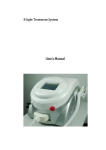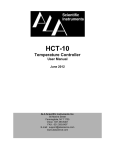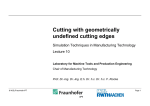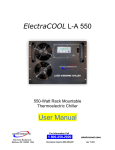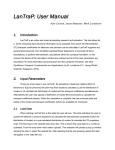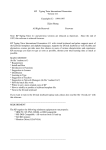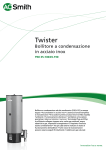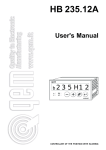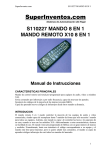Download On-Chip Thermoelectric Cooling Tool
Transcript
On-Chip Thermoelectric Cooling Tool ’User manual’ David Saenz March 28, 2011 1 Introducion Thermoelectricity is the study of the relationship between heat and electrical energy. There are two main thermoelectric effects, one on which a heat current through a thermocouple produces an electrical current (Seebeck effect) and one on which an electrical current produces a heat current (Peltier effect). Thermoelectric devices make use of these two effects to either produce power out of a temperature gradient, or generate a temperature difference between the two sides of the device by the use of electrical power. This simulation tool is intended to exemplify one of the main applications of the Peltier effect. A thermoelectric cooler or heat pump (commonly known as Peltier cell) is localized on the top of a microprocessor’s casing. Then, a heat sink is attached right on the top of it (this is a common layout on cooling applications). The Peltier cell will take heat from the chip and pump it towards the heat sink which dissipates it to the ambient when an electric current is made to flow trough it. We can compare the way this Peltier cooler works with a common refrigerator. We spend some amount of electrical energy to transport heat from one place to another. We can measure the process efficiency by taking the ratio of the useful work performed (heat being removed) to the energy expenditures. This efficiency is commonly represented by a Coefficient of Performance (COP). In common Peltier devices, this is very small, which means that we would have to invest a lot of energy to move a small amount of heat from one side to the other. This is why they are only used in applications where heir use is imprescindible. Otherwise, we can recur to a common gas compression refrigerator or other air conditioning systems. Cooling a chip with these devices is an example on which we need of these devices due to its small size, durability and maintenance free feature. 1 2 How to use this manual While science underlying thermoelectrics is quite complex, in this manual you will find an initial perspective of one of the applications of a thermoelectric cooler by keeping most of the intrincacies apart. And although an explanation of the formulas and the code embedded in this tool is provided in this manual, it has to be noted that these are only approximations to what it actually happens, and it is a good example of a real life case, which is the objective of the tool. This manual is presented as a step by step explanation on how to use the tool, as well as interpret the outputs. 3 Thermoelectric Device The layout of a common single-couple Peltier device is shown below: Figure 1: Thermoelectric Heat Pump This picture explains how this cooling business works. The process can be outlined as follows: 1. Cooper connects the n- and p-type semiconductor materials electrically in series and thermally in parallel. 2. Current flows through the circuit in the direction indicated to transfer heat from the top part to the bottom part. Common Peltier devices are made of several of this junction connected electrically in series and thermally in parallel, as shown in the picture below: 2 Figure 2: Peltier Cell Schematic The contacts and semiconductor materials are sandwiched in between two slabs of insulating material (commonly ceramic). A real life device is shown below: Figure 3: Real Peltier Device If we take a close look to the edges of the device, we will be able to identify the several couples of semiconductor. Normally, a protective material is put on these edges to avoid damage to the semiconductor couples. Also, when using these devices, one must be careful not to exceed a maximum working temperature specified by the manufacturer so to keep the soldier connecting the device from being melt, or other irreversible damage to the device. 4 Thermoelectric theory Thermoelectric phenomena arise out of inter-coupled electrical and thermal currents in a material. As stated in the introduction, Seebeck and Peltier effects are the main thermoelectric effects. They both happen simultaneously in a thermoelectric device. One can connect a TE device to a voltage source and make an electrical current flow through the junctions inside to generate a heat flow (Peltier effect). At the same time, such heat flow produces an electrical current through the device (in opposite direction to the existing current) and a voltage drop is developed throughout. Furthermore, this would turn out to be a complicated relation, but we will keep it simple. In a few words, the voltage source would have to overcome the voltage drop produced by the heat flow generated through the TE device (Seebeck voltage) and the one produced 3 by the actual device to make current flow. This process will dissipate heat according to the ohm’s law; W = V ∗ I. Other heat source would be the chip power dissipation (Qte ). Then one can map the heat currents through the layout ad come up with equations describing the flow of heat. Let’s start with a simple one-couple device: Figure 4: Thermoelectric Heat Pump (Dual Semiconductor Pellet) For each metal-semiconductor-metal junction (two in the above figure): Heat will be pumped from the hot side according to the formula q = πI (1) Where q can be called the ’heat current’ and π is the peltier coefficient, which describes the amount of heat current per unit charge. I is just the electric current through the materials. In turn, while powering the device, the power dissipated as heat flows half towards the hot side and half towards the cooled side. This is simple joule heat described by ohm’s law as: I 2R (2) But we find convenient to express the electrical resistance R as a function of the geometrical dimensions of the thermocouples. Assuming the p- and n-type elements within the TEC are the same shape and size and neglecting contact resistance, we can express the electrical resistance of the single pellet cooler module as: R = ρ(length/area) = ρ/G 4 (3) where ρ stands for the electrical resistivity of the semiconductor material. And although in reality, n- and p-type pellets have different ρ, we will assume uniformity between both. Also we will call the ratio of the area to length of the element gamma factor (G) for simplification. The last heat contribution to the system is the one generated by the voltage drop due to the Seebeck voltage through the TEC. It is easily calculated by multiplying this thermoelectrically generated voltage by the total current flowing through the device, (V ∗ I): QV.Seebeck = Iα∆T (4) Where α is the Seebeck coefficient and ∆T is the difference in temperature between the hot and cold side of the TE device (heated and cooled respectively). I is again the electrical current that flows through the TEC. Now that we have found the heat current through the system and explained how the single-coupled TEC works, we can turn our attention to the simulation and the math. 5 Simulation Thermal resistances are present within a junction of two objects. These resistances will make heat not to flow uniformly through the components and will develop a change in temperature. This is what we are interested in, knowing the temperatures at the different stages of our layout. If we want to know the temperature at a certain point on the system, we just need to multiply the heat current at the interested stage, by the thermal resistance at the corresponding junction. This process can be compared to electrical circuit calculations. One can take heat current as being electrical current, voltage at a resistance as the temperature of the junction, and electrical resistances as thermal resistances (we can use this analogy due to the 1D system assumption). As an example, lets take the heat current flowing from the TEC to the heat sink q and multiply it by the thermal resistance between that specific junction. The result would yield the junction temperature, just as multiplying the electrical current times an electrical resistance yields the voltage drop across it. To find the temperature at the heat sink-ambient junction, we would just have to add the ambient temperature to the temperature resulting by multiplying the thermal resistance in the heat-sink to ambient junction and we are good! Now we can come up with heat balance equations describing the temperature at each section of our layout. In the application mentioned in the introduction, the TE cooler (TEC) is put in between the chip case and the heat sink as shown below: 5 Figure 5: Chip Layout Heat flows from the chip to the case, then it is pumped through the peltier device, and then dissipated by the heat sink. Some assumptions are made in this case: 1. One dimensional system. 2. Heat flows only due to conduction processes. 3. Temperature is absolute and invariable on each part of the setup. 4. Temperature independent thermoelectric parameters. 5. No thermal resistance between electrical junctions within the TEC. 6. No thermal masses; instant heat transmission (no transient state). The image below shows the heat currents through the device and the thermal resistances at the junctions: Figure 6: Thermal Profile Heat currents are the big red arrows, each labeled with a number on the tail (1 and 2). Thermal resistances are represented as electrical resistances through the diagram. The temperature at each junction can be found by multiplying the total heat current through the junction by the corresponding thermal resistance and adding the corresponding temperature from the past junction. 6 Let’s first find the equations describing the thermal fluxes. For the total heat current # 1 (the total cooling capacity of the thermocouple), we have to take into account the following fluxes: 1. Heat being pumped by the TEC away from the chip case. 2. Heat dissipated by the TEC towards the chip case. 3. Heat transmission from hot side of the TEC to the cold side due to Fourier’s law. Thus if we say that Qm is the total heat current on the bottom side of the single thermocouple TEC, Qm = 1 + 2 + 3 (5) And multiplying by the number of thermocouples, the equation becomes Qm = 2N (1 + 2 + 3) (6) Where: 1. = αTc I 2. = −I 2 ρ/2G 3. = −kG(Th − Tc ) Where Tc and Th are the cold and the hot side of the TEC respectively and k is the thermal conductivity of the thermoelectric elements. The negative side indicates backflow of heat. And we get our first equation for heat current looking something like this: Qm = 2N (αTc I − I 2 ρ/2G − kG(Th − Tc )) (7) Now let’s analyze the flux after the TEC. Let’s say now that Qte is the power dissipated by the thermoelectric cooler. Thus we would have to take into account two heat current contributions to the system: 1. Power dissipation due to joule heating in the device. 2. Power dissipation due to Seebeck voltage drop. 7 Just as before, we have to multiply the total addition of the fluxes by the number of thermocouples. The equation for the TEC heat contribution would then look like: Qte = 2N (1 + 2) (8) Where: 1. = I 2 ρ/G 2. = αI(Th − Tc ) And we get our second equation for heat current: Qte = 2N (I 2 ρ/G + αI(Th − Tc )) (9) Now we just need to calculate the localized temperatures at each of the interfaces by multiplying the corresponding flux addition times each thermal resistance and adding any preexisting heat. Equations would look like: 1. Qm = 2N (αTc I − I 2 ρ/2 ∗ G − kG(Th − Tc )) 2. Qte = 2N (I 2 ρ/G + αI(Th − Tc )) 3. Tchip = Tc + Qm (Rchip−case + Rcase−T EC ) 4. Thot = T0 + (Qm + Qte )(RT EC−H.Sink + RH.Sink−Amb ) Here, in equation 2, we multiplied the thermal resistances Rchip−case + Rcase−T EC by its corresponding thermal current and then added the temperature at the cold side of the TEC to get the total temperature at the chip junction. Similarly, to find the temperature at the hot side of the TEC, we multiply the thermal resistances RT EC−H.Sink + RH.Sink−Amb times the corresponding heat current and then add the ambient temperature. Analyzing these equations, we realize that there are four unknowns, Th , Tc , Tchip and Qte . The user can fix Qm and I on the simulation. Thus, a system of four equations and four unknowns is developed. The recommended method to solve this system is by using the ”rref” (row reduce echelon form) function from MatLab once the corresponding matrix has been found. Below, the code used to solve these equations is shown. 8 Matrix = [(2*N*(alpha*I+K*G)) 0 0 (Qm+N*I^2*rho/G); (-2*N*alpha*I) 1 0 (2*N*I^2*rho/G); 0 1 -(R2 + R3)) 0 (T0 + Qm*(R2 + R3)); -1 0 0 1 (Qm*(R0+R1))]; (2*N*alpha*I) (-2*N*K*G) M = rref(Matrix); This would yield the result for each of the variables for given values of Qm and I. A full copy of the code is available under request. 6 Input & Output Default values are set for a common device. There are three categories for user input. 1. TEC characteristics. 2. Thermal Resistances. 3. Analysis Type. Each of them is briefly discussed below. 6.1 TEC Characteristics • No. of N-P couples.- This is the number of thermoelectric n- and p-type material couples in the Peltier cell. • Seebeck Coefficient.- This is the coefficient of proportionality indicating how much voltage is generated through the device per temperature difference. Units are in volts per kelvin(V/K) • Electrical Resistivity.- An average resistivity of n- and p-type materials. In units of ohm per meter (ohm*m). • Gamma Factor.- The ratio of a thermoelectric element ( single cube of semiconductor element) to its length. In units of meters (m). 9 • Thermal Conductivity.- A measure of the ability of the TEC to transfer heat per unit time, given one unit area and the temperature gradient through the thickness of the device. In units of watts per meter per degree Kelvin (W/m-K). 6.2 Thermal Resistances In here the user specifies the thermal resistances of each of the junctions in the device in units of degree kelvin per Watt (K/W). • Chip to Case. • Case to TEC. • TEC to Heat Sink. • Heat Sink to Ambient. 6.3 Analysis Type • Analysis.- Here the user can choose whether to sweep for maximum cooling capacity or current input to the TEC. • Ambient Temperature.- The temperature of the heat sink surroundings in degrees Kelvin (K). • Current Feed.- Current through TEC (only for Sweep Power Dissipation analysis) in units of Amperes (A). • Power Dissipation.- The maximum power pumped out of the chip (only for Sweep Current Input analysis) in units of Watts (W). • Maximum Plot Range.- Maximum range for each kind of simulation. • Minimum Plot Range.- Minimum range when plotting in sweep current mode. 6.4 Output There is a graph for each of the variables in the equations solved earlier in the manual. There is also a plot of the temperature difference across the TEC labeled as Thot Tcold, as well as one for the figure of merit of the device. Below summary of output graphs. 1. Cold Side Temperature of the TEC. 10 2. Hot Side Temperature of the TEC. 3. Thot-Tcold. 4. Chip Temperature. 5. Power Dissipated by the TEC. 6. Figure of Merit. Each of these graphs is self explanatory. References [1] D. K. C. MacDonald, Thermoelectricity an introduction to the principles. Dover, New York, 1st Edition, 2006. [2] Mark Lundstrom, Thermoelectric Nanotechnology. https://nanohub.org/resources/9421, 2010. [3] TXL Group Inc, Thermoelectric Generation Developer’s Kit. TXL Group Inc., Texas, 1st Edition, 2009. 11












